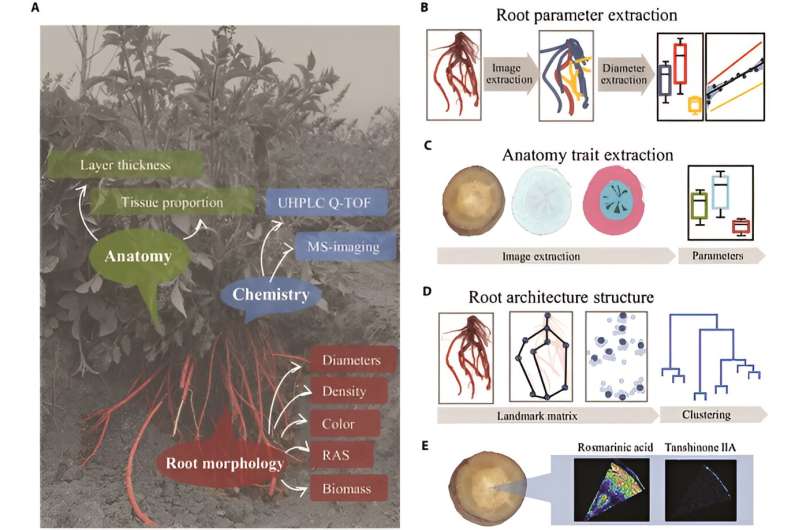This article has been reviewed according to Science X's editorial process and policies. Editors have highlighted the following attributes while ensuring the content's credibility:
fact-checked
proofread
Key insights into Salvia miltiorrhiza roots for medicinal plant breeding

Plant phenomics, an emerging field using advanced image recognition and algorithms, focuses on understanding and quantifying plant traits to improve crop breeding. Significant strides have been made with the advent of automated systems and machine learning techniques.
However, the field faces challenges in fully capturing the complexity of plant physiology, particularly in root system phenotyping. Salvia miltiorrhiza (Danshen), prized for its medicinal properties and market demand, epitomizes this research void.
Despite progress in understanding its bioactive compounds, a significant gap remains in broader physiological and phenotypic studies, especially of its roots. Addressing this gap is crucial, as it could revolutionize breeding and cultivation practices for this and similar medicinal plants.
Plant Phenomics published a research article titled "Phenotyping of Salvia miltiorrhiza Roots Reveals Associations between Root Traits and Bioactive Components."
In this study, a comprehensive workflow was employed to dissect the complex phenotypic landscape of Salvia miltiorrhiza roots. Using WinRHIZO and RhizoVision Explorer, the research extracted agronomic features from high-resolution scanned images, yielding 81 parameters across 102 root images.
These parameters, particularly Total Length, Surface Area, and Volume demonstrated a strong linear correlation with actual biomass, indicating their efficacy in predicting root biomass. Additionally, the study utilized Rootscan for anatomical analysis and RootScape for a detailed root system architecture (RSA) classification using a landmark-based approach. This led to the clustering of roots into distinct RSA groups, further characterized by diameter classification and K-means clustering.
Metabolic profiling revealed the distribution of primary active components like phenolic acids and tanshinones across root tissues. Notably, certain metabolites exhibited substantial associations with specific phenotypic features, such as Volume Range 4 and Total Surface, suggesting that these traits could influence metabolite production.
Furthermore, machine learning algorithms, particularly Random Forest (RF) and Gradient Boosting (GB), were employed to evaluate the classification accuracy of the roots. RF and GB emerged as the most effective models, surpassing other machine learning and deep learning models. Ultimately, the study established a significant linear regression relationship between the content of specific bioactive compounds and digital biomass based on Total Surface. This finding implies that the production of these compounds can be quantitatively predicted without traditional chemical methods.
In conclusion, this study established a multidimensional workflow for phenotyping S. miltiorrhiza roots that successfully predicted biomass and metabolite content from phenotypic traits. Unlike traditional methods, it integrated different analytical tools for a comprehensive approach, highlighting the need for species-specific software.
The research not only advances our understanding of root traits and their correlation with bioactive compounds but also paves the way for future applications in dynamic root modeling, stress response analysis, and cultivation optimization, providing valuable insights for breeding and cultivation strategies.
More information: Junfeng Chen et al, Phenotyping of Salvia miltiorrhiza Roots Reveals Associations between Root Traits and Bioactive Components, Plant Phenomics (2023). DOI: 10.34133/plantphenomics.0098
Provided by Plant Phenomics




















